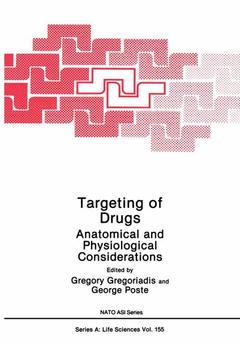Targeting of Drugs, Softcover reprint of the original 1st ed. 1988 Anatomical and Physiological Considerations NATO Science Series A: Series, Vol. 155
Langue : Anglais
Coordonnateurs : Gregoriadis Gregory, Poste George

A major vehicle for the transition of carrier-mediated drug delivery from a theoretical/experimental status to one with practical uses has been the NATO Advanced Studies Institute series "Targeting of Drugs". Three previous ASls of the series[1-3], also held in Cape Sounion, dealt with carriers of natural and synthetic origin, their preparation and drug incorporation as well as a wide range of applications. This book contains the proceedings of the 4th NATO ASI "Targeting of Drugs: Anatomical and Physiological Considerations" held in Cape Sounion, Greece during 20 June - 1 July 1987. Historically, carrier systems have been chosen on the basis of selective affinity for target sites. For instance, monoclonal antibodies bind selectively to antigens on the surface of cells and the same applies to ligands such as certain glycoproteins which bind to cell receptors. Colloidal carriers on the other hand, are "passively" targeted to the reticuloendothelial system. However, effective drug delivery depends not only on demonstration of affinity of the carrier system for its target but also, and perhaps crucially, on the way(s) by which the carrier-drug entity interacts with the interposed biological milieu. The book deals in depth with a number of biological milieus as travelled space for carriers en route to their destination, difficulties arising from unfavorable milieu-carrier interactions and ways to circumvent such difficulties. It also identifies, when possible, situations where proposed uses would or would not be realistic and provides perspectives for future goals.
The Structure of Different Types of Liver Cells in Relation to Uptake and Exchange Processes.- The Lymphatic System in Drug Targeting: An Overview.- The Hepatic Receptor for Asialoglycoproteins: Search for a Function.- The Galactose-Particle Receptor on Liver Macrophages: Biological Function and Implications for Clearance of Particulate Material.- Free Radicals in Health and Disease: Implications for Drug Delivery and Targeting.- Monoclonal Antibodies and Drug Targeting in Cancer.- Immunotoxins in Cancer Therapy.- Techniques for Ex-Vivo Bone Marrow Treatment with Immunotoxins.- The Potential of Membrane-Acting Toxins for Targeted Cancer Therapy.- In Vivo Uptake and Processing of Liposomes by Parenchymal and Non-parenchymal Liver Cells: Application to Immunotherapeutic Treatment of Hepatic Metastases.- Platelet Activating Factor, a Potent Mediator of Allergy, as a Structural Component of Phosphatidylcholine Vesicles.- Phospholipid Stereospecificity in Liposomal Modulation of Nitrogen Mustard Action.- Niosomes: A Putative Drug Carrier System.- The Immunoadjuvant Action of Liposomes: Optimization Studies.- Targeting of Antigens to Antigen-Presenting Cells and Their Activation: A Requirement for Vaccine Development.- Targeting Using Physical Approaches and Particulate Drug Carriers: Interaction with the Biological Milieu.- Pragmatic Approaches to Delivery of Peptides and Proteins as Drugs.- Reconstituted Influenza Virus Envelopes as a Potential Carrier for Fusion-Mediated Microinjection of Macromolecules into Living Cells.- Contributors.
Date de parution : 03-2012
Ouvrage de 222 p.
17.8x25.4 cm
Thèmes de Targeting of Drugs :
Mots-clés :
Antigen; bone; cancer; cancer therapy; cell; drug; drug delivery; lipide; research; vaccine
© 2024 LAVOISIER S.A.S.



